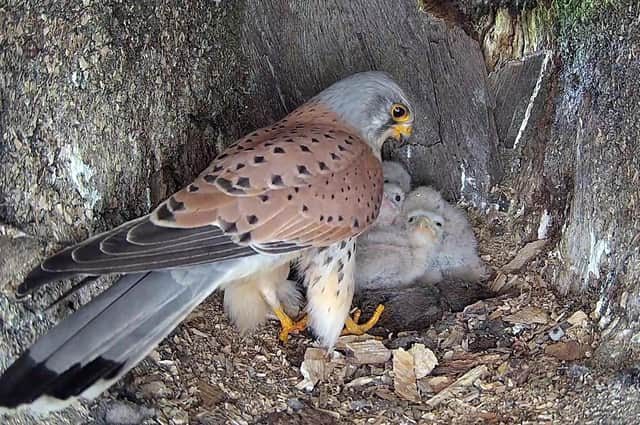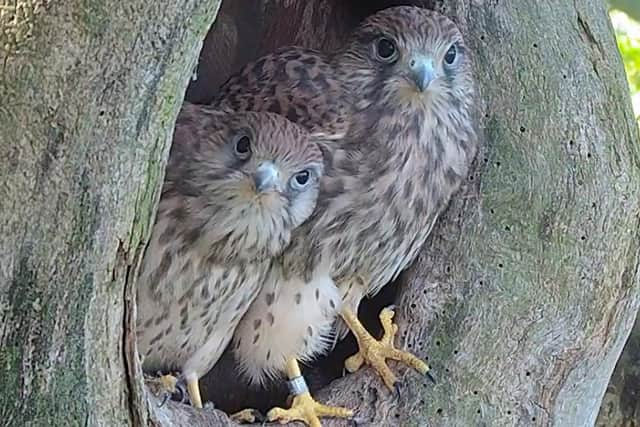North Yorkshire wildlife artist Robert E Fuller helps a 'single dad' kestral raise six chicks


Mr Kes, a long-term resident of my garden in Thixendale, became a single dad overnight after his partner suddenly disappeared, leaving their six chicks alone.
I’m not entirely sure why Mrs Kes disappeared, but the cameras in my garden recorded an altercation with a tawny owl on the night she fled.
Advertisement
Hide AdAdvertisement
Hide AdThe chicks were just a week old and too young to survive without their mother. So, after they had been alone all night, I decided to check on them.


The chicks were cold and the youngest three were very weak, so I decided to take these into my care. I slipped a heat mat under the others to keep them warm and fed them.
Throughout that day Mr Kes brought food into the nest and left it in a pile next to the chicks. They were unable to eat the food, as they were still too young to swallow prey items whole.
They were getting hungry. Mr Kes seemed very confused and kept rushing out of the nest to call for Mrs Kes. Then, that afternoon, appearing to understand something was awry, he did something extraordinary. He tried to brood the three chicks.
Advertisement
Hide AdAdvertisement
Hide AdThis behaviour is virtually unheard of among male kestrels and even though he kept slipping off the writhing mass of chicks, and actually soon gave up, he earned praise from around the world as viewers of my live stream on YouTube watched on in amazement. Male and female kestrels do take turns at keeping their eggs warm and so males have a grasp of the concept, but once the chicks hatch out the males switch their attention to hunting for their family and don’t take part in the day-to-day tasks of brooding and feeding.
As night approached, I grew worried about leaving the chicks alone in the nest. Temperatures plummet after dark and there are tawny owls on the prowl. I was torn between leaving them there, in the hope that Mrs Kes would return, and taking them inside for safety.
At about 9pm I spotted her fly up to the entrance to the nest and for a moment I dared hope that all would be well. But she just paused for a few seconds at the entrance and then flew away, without even looking in at the chicks. She looked extremely agitated and wary, and I haven’t seen her since.
I waited to see if Mr Kes would try again to brood the chicks and for a short while it looked as though he was trying but then he too left and so I decided to bring the chicks in to spend the night with their siblings.
Advertisement
Hide AdAdvertisement
Hide AdI returned the stronger three chicks to the nest at dawn the next morning, in the hope that Mrs Kes would return. It was important to me that these chicks had every opportunity to grow up wild. However, they would have died without food so I popped back twice during the course of that morning to feed them.
By afternoon there was still no sign of Mrs Kes, but Mr Kes, who had continued to deliver food to the nest all morning, did something even more extraordinary. I noticed him trying to feed the chicks.
This behaviour really is unusual. In similar circumstances, kestrel chicks have been known to die surrounded by food because the males continue to put prey items into the nest but do not tear it up into sizes small enough for them to eat.
During the first three days of Mrs Kes’ disappearance, this is what Mr Kes did. He delivered some 30 voles and rodents and heaped them around the chicks.
Advertisement
Hide AdAdvertisement
Hide AdIt was quite distressing to watch the chicks get frantic with hunger with all this food around them. But then he happened to deliver a lizard and one of the kestrel chicks managed to swallow it whole.
It was as if this male kestrel seemed to realise that chicks can eat if they get smaller items. And so then, on his next visit, Mr Kes tore up a vole and the chicks hungrily devoured each morsel.
As Mr Kes mastered his technique, I continued to provide a supporting role. For the first few days I took the chicks extra meals three or four times a day, then, as Mr Kes got better at feeding, I reduced these feeds to twice a day and by the end of the second week I was only feeding them once a day. However, I continued to bring the chicks in at night because Mr Kes never did get the hang of how to brood them.
Meanwhile, the chicks in my care grew stronger and at two weeks of age they were ready to go back into the nest with their siblings. I carefully placed them in and then rushed back to my studio so that I could watch Mr Kes’ reaction to seeing his chicks again on my live screens.
Advertisement
Hide AdAdvertisement
Hide AdBut the male kestrel simply appeared in the nest with a beak-full of food and began sharing it out amongst all six chicks – he didn’t seem to notice that there were now three more hungry mouths to feed.
Mr Kes continued to care for all six of his chicks inside the nest until at a month old they began to fledge.
It was heartening to watch as the first three made their first, shaky flights to a nearby branch. But the remaining three, and the ones that had been in my care, seemed reluctant to go.
After two days without food these younger three chicks, still had not fledged and I worried they would starve. I took a food delivery up to the nest and thankfully after this one then fledged, but it was another three days before the final kestrel chick took to the skies.
Advertisement
Hide AdAdvertisement
Hide AdMr Kes is still feeding all six chicks outside the nest and will continue to do so for another month until they have learned to hunt for themselves.
It’s been an incredible journey watching these six kestrels grow into independent birds.
*The Robert Fuller Gallery in Thixendale, North Yorkshire is open daily, go to the website robertefuller.com for opening times. Watch the web cams on Robert Fuller YouTube channel.